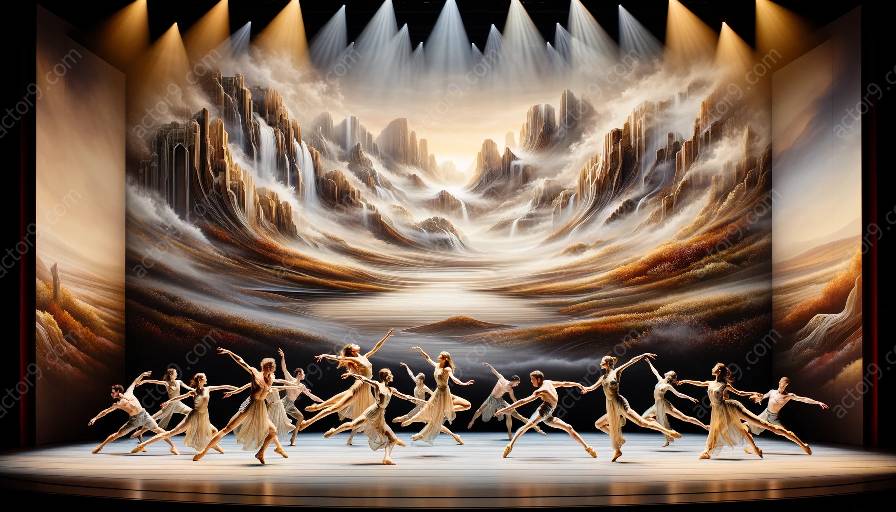Physical theatre choreography transcends traditional boundaries, incorporating spatial and environmental elements to create captivating and dynamic performances. This topic cluster delves into the innovative and expressive techniques that define physical theatre choreography, exploring how the space and environment become integral aspects of the storytelling process. Through this exploration, we unravel the intricate connection between movement, space, and environment in physical theatre, shedding light on the creative process and inspiring a deeper appreciation for this unique art form.
The Interplay of Space and Movement
In physical theatre, the utilization of space is a fundamental element that shapes the narrative and emotional resonance of a performance. Choreographers intricately weave together movement and spatial dynamics to convey stories, emotions, and themes. The exploration of space involves not only the physical dimensions of the performance area but also the creative manipulation of that space to immerse the audience in the theatrical experience.
Immersive Environments
Physical theatre choreography often extends beyond conventional stage settings, venturing into immersive environments that blur the boundaries between performers and spectators. The use of unconventional spaces and environmental interaction amplifies the sensory impact of the performance, inviting audiences to engage with the narrative on a profound level. This immersive approach challenges conventional notions of theatrical presentation, redefining the relationship between performers, the audience, and the surrounding environment.
Environmental Storytelling
Environmentally-informed choreography encompasses a broad spectrum of influences, including natural landscapes, urban settings, historical contexts, and abstract conceptual spaces. Choreographers draw inspiration from the environment to infuse performances with rich narratives and symbolic depth. The environment becomes a canvas for storytelling, with movements and interactions reflecting the essence of the surroundings, thereby establishing a powerful connection between the performers and the space they inhabit.
Innovative Techniques and Expressions
Exploring space and environment in physical theatre choreography demands a range of innovative techniques and expressions that defy traditional constraints. Choreographers experiment with site-specific performances, aerial maneuvers, interactive installations, and unconventional movement vocabularies to harness the full potential of space and environment as creative assets. These innovative approaches expand the scope of physical theatre, pushing the boundaries of traditional choreographic practices and inviting audiences to experience performances in fresh, unconventional ways.
Emotional Resonance Through Spatial Dynamics
The deliberate manipulation of space generates emotional resonance, compelling audiences to embark on an immersive journey through the interplay of physical movements and spatial dynamics. Choreographers employ spatial relationships, perspective shifts, and gestural interactions to create striking visual narratives that resonate deeply with the audience. By leveraging space as a narrative tool, physical theatre choreography transcends mere movement, offering an evocative tapestry of emotions and experiences that unfold within the spatial context.
Environmental Integration and Interaction
Physical theatre choreography embraces the concept of environmental integration and interaction, wherein performers seamlessly blend with their surroundings, intertwining their movements with the distinctive features of the environment. Whether utilizing natural elements, architectural structures, or digital technologies, choreographers orchestrate a harmonious fusion between performers and the environment, resulting in performances that are profoundly entwined with the spatial and sensory characteristics of the setting.
The Creative Process and Artistic Vision
The exploration of space and environment in physical theatre choreography offers a glimpse into the dynamic creative process and artistic vision that underpin each performance. Choreographers undergo meticulous planning and collaborative experimentation to sculpt performances that succinctly integrate movement, space, and environment. This process involves a synthesis of conceptual ideation, movement exploration, spatial choreography, and environmental adaptation, all of which converge to shape a compelling artistic vision that is realized through the lens of physical theatre.
Innovative Adaptation of Spaces
Physical theatre choreography showcases the innovative adaptation of spaces, transforming mundane locations into extraordinary stages that challenge traditional notions of performance settings. Whether it be abandoned warehouses, sprawling outdoor landscapes, or unconventional indoor environments, choreographers infuse these spaces with new life and purpose, illustrating the boundless potential of physical theatre in transcending spatial limitations and redefining the boundaries of the performance experience.
Artistic Collaboration and Spatial Dynamics
The collaborative nature of physical theatre choreography encourages a symbiotic relationship between artists, space, and environment. Performers, choreographers, set designers, and environmental artists work in tandem to craft performances that seamlessly interweave spatial dynamics with artistic expressions. This collaborative synergy unfolds as a dialogue between creative minds, resulting in performances that reflect the collective vision and inventive spirit of the artistic collaborators.
Inspiration for Future Explorations
Finally, the exploration of space and environment in physical theatre choreography serves as an enduring wellspring of inspiration for future creative endeavors. As the boundaries of traditional performance spaces continue to expand, choreographers and performers are poised to embark on new explorations of spatial and environmental dynamics. This ongoing journey into uncharted territories fuels a vibrant tapestry of inventive performances, propelling the evolution of physical theatre choreography into uncharted frontiers, and ultimately redefining the intersection of movement, space, and environment in the realm of contemporary performing arts.




































